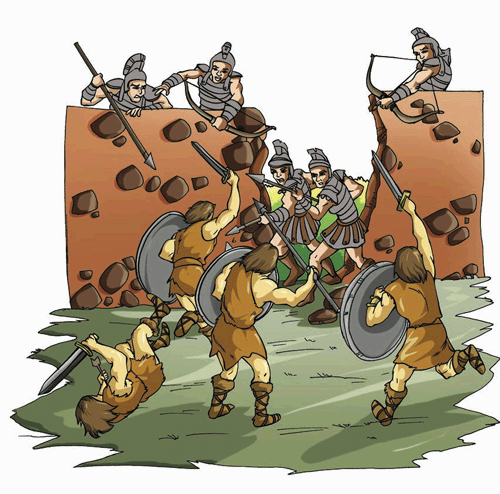English and Its Historical Development, Part 07
(the northern Picts broke through Hadrian's wall)
The Picts of Scotland broke through Hadrian's wall while the Saxons were devastating the Eastern coast

Northern tribes of Britain took advantage of a wall where fortifications were weakened or abandoned
In A.D. 197, the northern tribes of Britain were confronted only by walls and fortifications which had been wholly abandoned or else were held only by greatly weakened garrisons; as a result, they broke through the frontier and spread destruction all over the northern part of the Roman province.
From a military point of view, the extent of the disaster was immense. Hadrian's Wall was overthrown so completely that in many places, when the time came for restoration, it had to be rebuilt from it foundations; so, that there was some justification for the biographers of Severus when they claimed that he had in fact built the Wall and not merely repaired it.
Forts, milecastles, turrents; all show that there were abundant traces of destruction at this time of about A.D. 197.
Southwards from the frontier, the network of forts covering Brigantian territory indicated the same conditions, even as far as York.
The Picts broke through the wall more than once
The wall was destroyed twice by northern tribes, in A.D. 197 and A.D. 296, when its garrison was withdrawn for civil war, and again in A.D. 367-369 by concerted attacks from land and sea. It appears to have been evacuated after A.D. 383.
After the campaigns of Septimius Severus in Scotland during the early 3rd century, the northern frontier remained quiet until the confederation of Picts increased pressure in the 4th century.
The wall garrison was gradually weakened by withdrawals of troops to fight in Roman civil wars, but some military occupation continued into the early 5th century, when Britain ceased to be a Roman province.
The wall's dimensions
Hadrian's Wall was 80 Roman miles (73.5 English miles or 117 kilometers) long. Its width and height was often determined by the construction materials which were available in each area; for example, east of River Irthing, the wall was made from squared stone and measured three meters (9.7 feet) wide and five to six meters (16–20 feet) tall. West of the river the wall was made more from turf and measured six meters (20 feet) wide and three and a half meters (11.5 feet) high.
These specifics do not include the wall's ditches and forts. The central section measured eight Roman feet wide (7.8 feet or 2.4 meters) on a ten foot base.
Proceed to Part 8, Roman troops returned to Italy.
INDEX or Table of Contents, English and its historical development.
References: sources of information.
